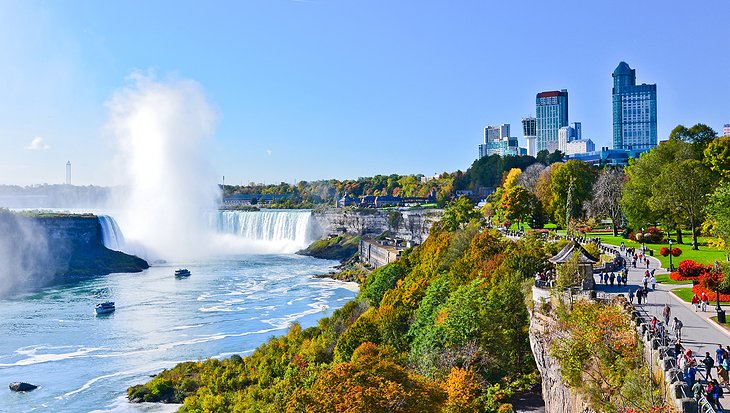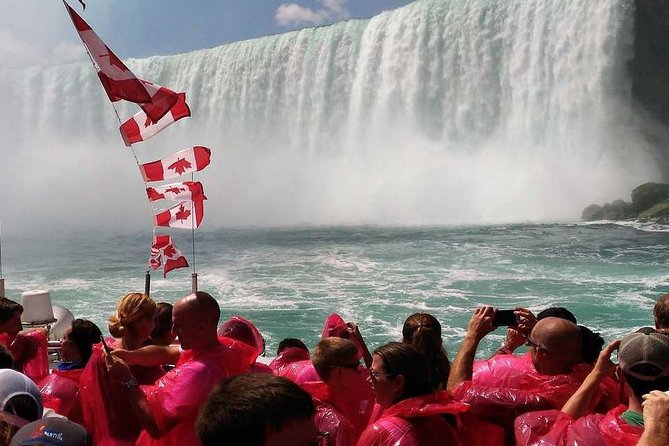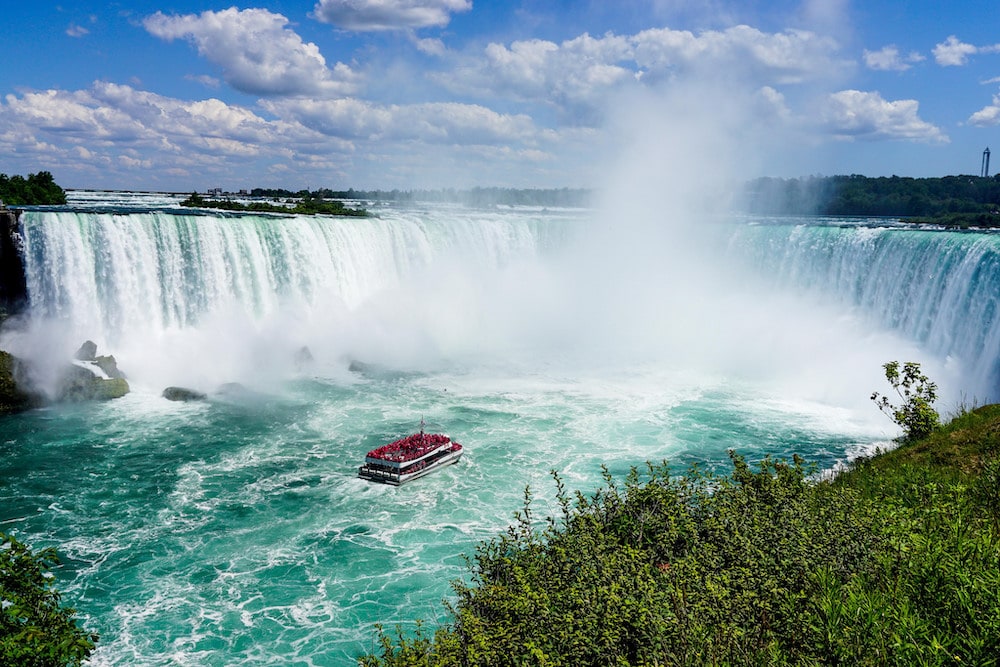Niagara Falls is one of the most breathtaking natural wonders in the world. Every year, millions of tourists from all over the globe flock to this majestic site to witness its beauty. But when is the best time to visit Niagara Falls on the Canadian side? In this blog post, we will discuss what makes it an ideal time to take a trip there and how to make the most of your visit.
Niagara Falls is one of the most popular tourist destinations in the world. Every year, millions of people visit to see the magnificent waterfalls. The Niagara Falls Canadian side is the most popular side to visit. It offers stunning views of the falls and many different activities for visitors.
Summer is the best time to visit Niagara Falls, the Canadian side. The warm and sunny weather makes it perfect for exploring everything the area offers. There are also many different events and festivals during the summer months. If you want to avoid the crowds, the shoulder season (May-June & September-October) is a great time to visit. The weather is still pleasant, and there are fewer tourists around.
When is the Best Time To Visit Niagara Falls, Canadian Side?
When planning a visit to the Canadian side of Niagara Falls, it is essential to consider the best time to experience this natural wonder’s beauty and majesty fully. The timing of your trip can significantly impact your overall experience, taking into account weather conditions, crowd levels, and availability of attractions.
The summer months, from June to August, are typically the most popular time to visit Niagara Falls. During this period, you can expect warmer temperatures and longer daylight hours, making it ideal for enjoying outdoor activities and exploring the various attractions around the falls. However, it is important to note that this is also peak tourist season, meaning larger crowds and higher prices for accommodations and attractions.
For those seeking a quieter and more budget-friendly option, visiting during the shoulder seasons of spring (April-May) or fall (September-October) can be a great alternative. The weather during these times is generally mild, with cooler temperatures compared to summer, but still pleasant enough for outdoor activities. Additionally, you can enjoy beautiful foliage in the fall or witness flowers blooming in spring.
If you prefer a more unique experience with fewer crowds and potentially lower prices on accommodations, visiting during the winter months (November-March) can be an option. While temperatures can drop below freezing during this time, and some attractions may have reduced operating hours or be closed due to ice formations or maintenance work, witnessing Niagara Falls partially frozen can be a truly breathtaking sight.
Choosing the best time to visit depends on your preferences regarding weather conditions and crowd levels. It is recommended to check weather forecasts and plan accordingly while considering factors such as budget constraints and desired activities when deciding when to visit the Canadian side of Niagara Falls.
Pros & Cons of Visiting Different Seasons
Each season offers a unique experience, and understanding the advantages and disadvantages can help you make an informed decision.
One of the pros of visiting during the summer season is that you will have pleasant weather, allowing you to enjoy outdoor activities such as boat tours and hiking fully. The falls are also at their most powerful due to increased water flow. However, remember that summer is peak tourist season, so expect larger crowds and higher accommodation prices.
Visiting in the fall offers breathtaking views as the foliage surrounding Niagara Falls transforms into vibrant red, orange, and yellow hues. The smaller crowds compared to summer also make it easier to explore attractions at your own pace. However, be prepared for cooler temperatures and potential rainfall.
Winter brings its own set of pros and cons. On one hand, witnessing Niagara Falls covered in ice can be a truly magical experience. You may also find discounted rates on accommodations during this off-peak season. However, extreme cold temperatures can make outdoor activities challenging, and some attractions may have limited operating hours or closures.
Springtime brings milder weather than winter, with blossoming flowers adding beauty to the landscape around Niagara Falls. It’s a great time for nature enthusiasts who enjoy hiking trails and exploring nearby parks. However, spring showers are common, so be prepared with appropriate rain gear.
Each season has its advantages and drawbacks when visiting the Canadian side of Niagara Falls. Consider your preferences for weather conditions, crowd levels, pricing, and available activities when deciding which season suits you best for visiting this natural wonder.
What Types of Activities Are Available Throughout The Year?
Niagara Falls is a year-round destination, but the best time to visit depends on what type of activities you want to do.
In the winter, the Falls are mostly frozen over, and you can even walk across the ice bridge that forms at the bottom of the Horseshoe Falls. It’s a surreal experience to be standing in the middle of all that rushing water with giant icicles hanging overhead. You can also ride a horse-drawn carriage through Queen Victoria Park or take a scenic helicopter tour.
Spring is when the crowds start to pick up, but it’s still a great time to visit. The weather is milder, so you can enjoy all the outdoor activities, and the flowers are starting to bloom in the gardens. This is also when most memorable events and festivals happen, like the Niagara Wine Festival and Folk Arts Festival.
Summer is peak season at Niagara Falls, so expect large crowds. But there’s plenty to do to keep everyone entertained, like taking a ride on the Maid of the Mist boat tour, walking behind the Falls at Journey Behind The Falls, or cooling off in one of the many splash pads around town.
Thanks to the stunning autumn foliage, fall is another popular time to visit. Take a scenic drive along Niagara Parkway for some of the best views, or hike one of the many trails in Niagara Glen Nature Centre.

Where to Stay and dine Nearby
When visiting the Canadian side of Niagara Falls, finding suitable accommodations and dining options to enhance your experience is important. Luckily, plenty of options for staying and dining near the falls are available.
For accommodations, numerous hotels and resorts are located close to Niagara Falls. Whether you prefer luxury hotels with breathtaking views or budget-friendly options, you’ll find a range of choices to suit your needs. Some popular hotel areas include Clifton Hill, Fallsview Boulevard, and Lundy’s Lane.
Regarding dining, the Canadian side offers a diverse culinary scene with something for every taste bud. From casual eateries to fine dining establishments, you’ll have no shortage of options for satisfying your hunger. Many restaurants boast stunning views of the falls, while others offer unique cuisine worldwide.
Additionally, various tourist districts such as Clifton Hill and Queen Victoria Park offer a mix of attractions and dining options within walking distance from each other.
Tips & Tricks for The Best Niagara Falls Experience
There’s nothing quite like Niagara Falls. Whether watching the mesmerizing waterfalls from the Observation Tower, taking a ride on the Maid of the Mist boat, or simply enjoying the views from your hotel room, Niagara Falls is an unforgettable experience.
If you plan a trip to see the falls, you may wonder when to visit. Here are a few things to keep in mind:
The peak season for Niagara Falls is June through August. This is when the weather is warmest, and the crowds are most significant. If you’re looking for lower prices and smaller groups, consider visiting during the shoulder season (May and September).
Water flow over Niagara Falls varies throughout the year. The highest flows typically occur in late spring (around April or May), while the lowest flows generally occur in winter (December through February). Remember this when planning your trip, as you may want to time your visit to coincide with higher or lower water flows.
No matter when you decide to visit Niagara Falls, there are a few tips and tricks that will help you make the most of your trip:
If possible, avoid visiting on weekends, as this is when crowds are at their worst. Weekdays tend to be much quieter.
Arrive early in the day to beat the crowds and find parking close to your desired attraction. Many attractions open early, so take advantage of this by getting there as soon as they open.

Is it better to stay on the Canadian side of Niagara Falls?
Both sides offer unique experiences and attractions, but there are a few factors to consider when making this decision.
Firstly, the view of the falls from the Canadian side is often considered more spectacular. The Horseshoe Falls, the largest of the three falls that make up Niagara Falls, can be seen in all its glory from various vantage points on the Canadian side. On the other hand, the American side offers a closer view of Bridal Veil Falls and allows visitors to experience being right at the base of the falls.
Secondly, staying Canadian provides easier access to many popular tourist attractions. Clifton Hill, known as “the street of fun,” is located on the Canadian side and offers various entertainment options, such as museums, arcades, and restaurants. Additionally, attractions like Journey Behind the Falls and Hornblower Niagara Cruises are easily accessible from this side.
Furthermore, staying on the Canadian side allows visitors to enjoy stunning views during daylight hours and at night. The nightly illumination of Niagara Falls creates a breathtaking sight that can be enjoyed from various viewpoints along the Canadian shoreline.
Lastly, it’s worth noting that crossing between both sides is relatively easy for tourists with proper documentation. However, staying on one side may save time regarding border crossings if you plan to explore primarily within Canada or the United States during your visit.
Ultimately, whether it’s better to stay on the Canadian or American side of Niagara Falls depends on personal preferences and priorities. Both sides offer unique experiences and stunning views of this natural wonder.
How many days do you need in Niagara Falls, Canada?
When planning a trip to Niagara Falls, Canada, it’s important to consider how many days you should allocate for your visit. The duration of your stay will depend on various factors, such as your interests, the activities you want to engage in, and whether you plan to explore other nearby attractions.
To fully experience the beauty and attractions of Niagara Falls, it is generally recommended to spend at least two to three days in the area. This allows ample time to take in the breathtaking views of the falls from different vantage points, such as observation decks or a boat tour on the Maid of the Mist.
Additionally, you can explore other attractions in Niagara Falls, including Clifton Hill, with its array of entertainment options like museums, arcades, and restaurants. The nearby Niagara-on-the-Lake region is also worth exploring for its charming town atmosphere and wineries.
If you have more time available or wish to explore further afield, consider extending your stay by a few more days. This will allow you to venture out and visit other nearby attractions like Toronto or take a scenic drive along Niagara Parkway.
Ultimately, the number of days needed in Niagara Falls depends on your preferences and schedule. However, dedicating at least two to three days will ensure you have enough time to immerse yourself in this iconic destination fully.
Is Niagara Falls in Canada worth it?
Niagara Falls is a hugely popular tourist spot. However, whether it’s worth visiting from the Canadian side depends on several factors.
Firstly, the natural beauty of Niagara Falls is truly breathtaking. The sheer power and magnitude of the waterfalls are awe-inspiring, making it a must-see attraction for many travellers. The Canadian side offers stunning panoramic views of the falls and several vantage points that allow visitors to get up close to the cascading water.
Additionally, Niagara Falls offers a range of activities and attractions beyond just viewing the falls. Visitors can take boat tours such as the famous Maid of the Mist or Hornblower Cruises, which provide an exhilarating experience by taking them right into the misty spray at the base of Horseshoe Falls. Helicopter tours are also available for those seeking a unique perspective from above.
Furthermore, Niagara Falls has developed into a vibrant tourist hub with numerous hotels, restaurants, casinos, and entertainment venues near the falls. This means that visitors have plenty of options for dining and accommodations during their stay.
However, it’s essential to consider potential downsides as well. Due to its popularity as a tourist destination, Niagara Falls can get crowded during peak seasons. This may result in long lines and difficulty finding parking spaces. Additionally, some individuals may find that commercialization has taken away from its natural charm.
Ultimately, whether or not Niagara Falls in Canada is worth it depends on personal preferences and expectations. If you appreciate natural wonders and don’t mind crowds or some level of commercialization in exchange for convenience and accessibility to various attractions, visiting Niagara Falls in Canada can be an unforgettable experience.
- Yonge-Dundas Square in Toronto is Now Called “Sankofa Square” - December 17, 2023
- Best Western Brooks’ SureStay Plus debuts in Alberta - December 16, 2023
- Air Canada Arrives in Tulum, Mexico as the First Canadian Airline - December 16, 2023




